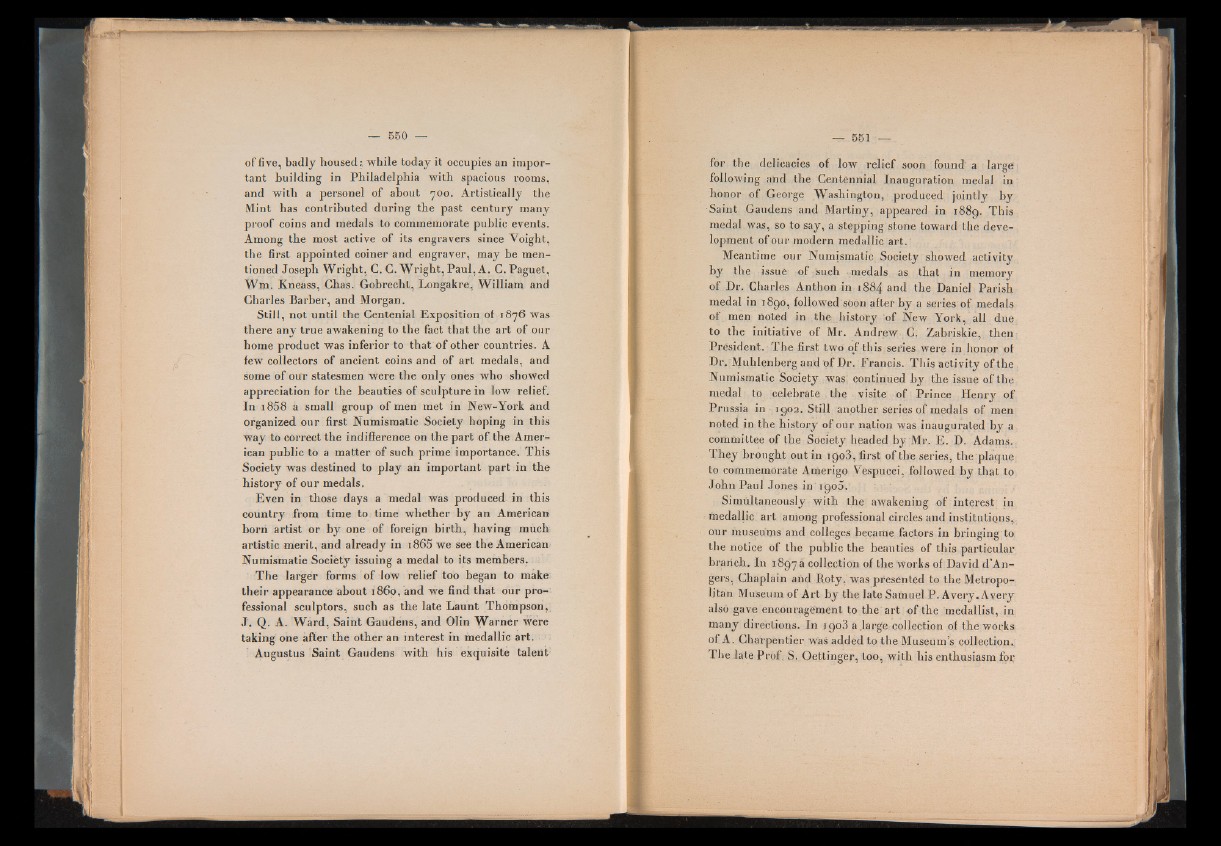
of five, badly housed; while today it occupies an important
building in Philadelphia with spacious rooms,
and with a personel of ahout 700. Artislically the
Mint has contributed during the past century many
proof coins and medals to commemorate public events.
Among the most active of its engravers since Voight,
the first appointed coiner and engraver, may be mentioned
Joseph Wright, C. C. Wright, Paul, A. G. Paguet,
Wm. Kneass, Chas. Gobrechl, Longakre, William and
Charles Barber, and Morgan.
Still, not until the Gentenial Exposition of 1876 was
there any true awakening to the fact that the art of our
home product was inferior to that of other countries. A
few collectors of ancient coins and of art medals, and
some of our statesmen were the only ones who showed
appreciation for the beauties of sculpture in low relief.
In i 858 a small group of men met in New-York and
organized our first Numismatic Society hoping in this
way to correct the indifference on the part of the American
public to a matter of such prime importance. This
Society was destined to play an important part in the
history of our medals.
Even in those days a medal was produced in this
country from time to time whether by an American
born artist or by one of foreign birth, having much
artistic merit, and already in i 865 we see the American
Numismatie Society issuing a medal to its members. :
The larger forms of low relief too began to make
their appearance about i860, and we find that our professional
sculptors, such as the late Launt Thompson,
J . Q. A. ’Ward, Saint Gaudens, and Olin Warner were
taking one after the other an interest in medallic art. :
Augustus Saint Gaudens with his exquisite talent
for the delicacies of low relief soon found a large
following and the Centennial Inauguration medal in
honor of George Washington, produced jointly by
Saint Gaudens and Martiny, appeared in 1889. This
medal was, so to say, a stepping stone toward the development
of our modern medallic art.
Meantime our Numismatic Society showed activity
by the issue of Such medals as that in memory
of Dr. Charles Anthon in 1 8 8 4 and the Daniel Parish
medal in 1890, followed sOOn after by a series of medals
of men noted in the history 'of New York, all due
to the initiative of Mr. Andrew C. Zabriskie, then:
President. The first two 0/ this series were in honor of
Dr. Muhlenberg and of Dr. Francis. This acti vity of the
Numismatic Society was' continued by the issue of the
medal to celebrate the visite of Prince Henry of
Prussia in 1902. Still another series of medals of men
noted in the history of our nation was inaugurated by a
committee of the Society headed by'Mr. E. D. Adams.
They brought out in 1903, first of the series, the plaque
to commemorate Amerigo Vespucci, followed by that to
John Paul Jones in 1900.'
Simultaneously with the awakening of interest in
tnedallic art among professional circles and institutions,
our museums and colleges became factors in bringing'to.
the notice of the public the beauties of this particular
branch. In 1897 a collection of the Works of David d ’An-
gers, Ghaplain and Roty, was presented to the Metropolitan
Museum of Art by the late Samuel P. Avery. Avery
also gave encouragement to the art of the medallist, in
many directions. In 19°^ a.large collection of the works
of A. Charpentier was added to the Museum’s collection.
The late Prof. S. Oettinger, loo, with his enthusiasm for